As Kyiv embarks on a new year of attritional warfare, speculation is swirling about future supplies of the U.S.-made ATACMS that Ukraine has used so dramatically against Russian forces in the east and south of the country.
Kyiv debuted its ATACMS missiles in blitz attacks on Russian military bases in the cities of Berdyansk and Luhansk in mid-October 2023. The M39 ATACMS rockets took out a slew of Moscow's helicopters, with Ukrainian President Volodymyr Zelensky commenting the missiles had "proven themselves."
The U.S. has sent around 20 ATACMS so far, The New York Times reported, citing two Western officials. These missiles were used "immediately and with great effect" by Ukraine, Lieutenant General (Retired) Ben Hodges, former commander of U.S. Army Europe, told Newsweek.
With the war showing no signs of coming to an end anytime soon, questions are emerging over the future use of the long-range missiles, with attention focusing on U.S. stockpiles of expired ATACMS.

There are various types of ATACMS with different ranges and warheads.Hundreds of Lockheed Martin-made M39 and M39A1 missiles that are "excellent legal, precision-guided cluster weapons" are scheduled for destruction at "significant" expense to American taxpayers, said Daniel Rice, a former special adviser to Ukraine's lead commander, General Valery Zaluzhny.
They could be shipped off to Ukraine and used "very effectively" against Moscow's forces, he told Newsweek.
There are no concerns about the expiry date of this type of missile, he insisted.
"They work," he added. "All weapons are eventually replaced by better, more lethal, more cost-effective weapons," he said, but they could make all the difference for Ukraine's war effort.
"These M39 missiles add a range, accuracy and lethality that Ukraine does not have without this donation," he said.
A lot hinges on just how far past the expiry date a weapon is, but a missile could have even years of life left in it past this date, said Hodges. Not sending ATACMS based on shelf life is a political decision, rather than one concerned with safety, he added.
A given shelf-life is not always an accurate indicator of whether a missile is functional, agreed Fabian Hinz, a research fellow specializing in Middle East defense and military analysis at the International Institute for Strategic Studies think tank.
The ATACMS provided to Ukraine are thought to have a range of around 100 miles. Around 1,650 of the Block I missiles—the type supplied to Ukraine—were made in the decades since they were introduced, according to Reuters. Fewer than 1,114 M39 and M39A1 warheads are still in U.S. stores, the news agency reported in mid-October, with many having been used in U.S. operations or having undergone modification.
The key part is keeping the motor of a solid-propellant rocket in good condition, he told Newsweek. This all depends on the manufacturing quality and the conditions under which the missiles are stored, he said, as it is "not very forgiving when it comes to minor issues."
With ATACMS—which use a single-stage solid propellant motor—there would need to be some quality control, but the shelf life "could be higher than advertised," Hinz said.
Longer-range MGM-140 ATACMS are still used by the U.S., presenting a different and more difficult political and military challenge, Rice said. But there are "tens of thousands" of outdated rockets of various types that Ukraine could fire from HIMARS waiting to be destroyed, he said, and the U.S. is also looking towards its new Precision Strike Missile to take the ATACMS' place.
With enough M39s, Ukraine could disrupt Russian supplies from Crimea to its forces in southern Ukraine, also known as the land bridge, Rice said. From where the front lines are currently located in the south and the east of the country, Ukraine's M39 ATACMS can reach the Sea of Azov and target key assets in Russian-occupied territory, he added. With more ATACMS, Ukraine can make "prime targets" out of Russian bases, infrastructure and troop formations across tens of thousands of square miles of territory, he said.
With nearly 1,000 sub-munitions in each M39 rocket, more cluster ATACMS mean higher Russian casualties, Rice added.
But cluster variants have shorter ranges, and are not suited to striking Russian infrastructure or assets close to inhabited areas like the Crimean port city of Sevastopol, Hodges said. The operational requirement for more ATACMS, including the unitary warhead version, is "absolutely there," he said.
More ATACMS would give Ukraine the tools to undermine Russia's troops in every square mile of Ukraine, and make its military and logistical presence in Crimea untenable, added Hodges. There is no good reason not to provide the weapons, he said.
Update 01/02/2024 at 1:30 p.m. ET: This article was updated with comments from Lt. Gen. (Retired) Ben Hodges.
Uncommon Knowledge
Newsweek is committed to challenging conventional wisdom and finding connections in the search for common ground.
Newsweek is committed to challenging conventional wisdom and finding connections in the search for common ground.
About the writer
Ellie Cook is a Newsweek security and defense reporter based in London, U.K. Her work focuses largely on the Russia-Ukraine ... Read more
To read how Newsweek uses AI as a newsroom tool, Click here.








